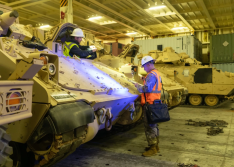Air Force intends to stand up new Integrated Capabilities Command by end of 2024

The Air Force has begun charting a path to standing up a brand new organization that will drive the service’s modernization requirements, and Chief of Staff Gen. David Allvin said he plans to have the first personnel begin working on the effort by the end of this year.
The so-called Integrated Capabilities Command (ICC) was one of 24 organizational changes announced in February as part of Secretary of the Air Force Frank Kendall’s push to “reoptimize” the service for future warfare. The new major command will be led by a three-star general and use a single force design to develop operational concepts, integrated capability requirements and modernization plans for the entire Air Force.
Speaking to a small group of reporters Thursday, Allvin said the service is in the process of identifying the personnel that will be part of the ICC, most of whom will be pulled from existing major commands. The target right now is to have 500 to 800 people working in the command, with the first of those assignments beginning before the end of 2024.
“The idea of Integrated Capabilities Command is really to take that expertise — the requirements generation, those that understand the functional expertise in their operations, and they’re part of the Air Force — and put them together and start understanding what we need the Air Force to do as far as mission outcomes,” Allvin explained.
By establishing the new organization, the service hopes to address a capability development process that Allvin described as “diffused and fragmented” across each major command today.
Currently, individual major commands are tasked with generating new requirements for both current and new platforms and rarely consult with other commands. For example, Air Combat Command is focused on the current and future fleet of fighter jets, while Air Mobility Command is responsible for systems that conduct logistic missions like tankers and transport aircraft.
As a result, systems are being developed in pieces — creating challenges in the Air Force’s ability to effectively modernize in alignment with a single force design, Allvin said.
“We want to be able to keep up with the pace of technology, the pace of change and have the operators come together to build one force design rather than multiple parts that are sort of stitched together at the end,” he said.
The vision for the ICC is to have personnel from each major command — likely individuals who work in strategic planning and requirements roles — consolidated under a single organization and have them create capability requirements that are driven by one Air Force-wide force design.
Allvin emphasized that managing the relationship between the ICC and other major commands is going to be critical as the service evolves to this new paradigm of doing business. Over time, the hope is that ICC personnel will approach problems first through the lens of an overall mission outcome and then go back to their respective operational expertise to present solutions.
“It’s a critical linchpin to be able to make the Integrated Capabilities Command effective,” he said. “You have that depth of understanding of the individual MAJCOM, but you now change your understanding to overall integrative force design.”
To that end, Allvin said the Air Force is still working through options of where the ICC will be headquartered but is considering standing up “satellite locations” during the initial stages to ensure the connections with each major command aren’t severed.
“I would anticipate something like that will be sort of the first phase of getting operational, and then we’ll decide whether we need to get a second phase,” he said.
The ICC will also address issues in prioritizing the several demand signals that come from each major command, Allvin noted. What resources are allocated to what modernization efforts will be decided by the command based on the Air Force’s guiding force design, with both the chief of staff and the service’s secretary approving final decisions, he said.
As for when the ICC will take over development of some of the major modernization projects — such as the Next-Generation Air Dominance family of systems — Allvin said that is yet to be determined. Right now, the service is focused on defining the roles and responsibilities of ICC personnel and seamlessly transitioning them into their new positions, he added.
“That transition, it has to be carefully managed,” Allvin said. “But we cannot afford to go so slow that it stalls and stagnates, and it makes it easier to go back.”






